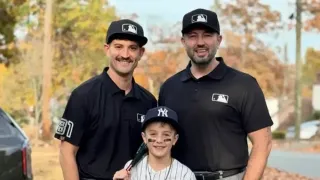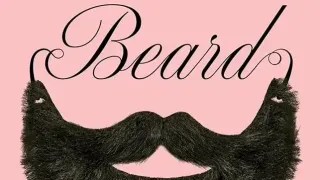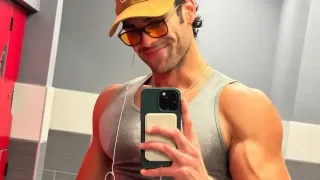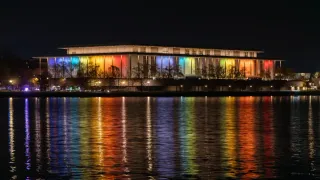April 6, 2021
Screen Times: Film Coverage in the B.A.R. Through 50 Years, Part 2
Brian Bromberger READ TIME: 15 MIN.
As the 1990s approached, films began to offer more positive portrayals of LGBTQ people, often as the loyal best friend/confidante, with characters beginning to be more fleshed out, having lives rooted in their sexuality but not necessarily ruled only by it (i.e. Fried Green Tomatoes, 1991). Straight society could identify with the queer search for happiness despite facing oppression and traditional values (i.e. The Adventures of Priscilla, Queen of the Desert, 1994).
One remaining taboo was public displays of affection and intimacy, especially two men kissing. That hurdle would be overcome in the 2000s (and even lampooned in the 1998 indie Billy's Hollywood Screen Kiss, B.A.R. July 23, 1998) as major movie stars sought to play queer sexually active characters, which in decades past could have meant the end of a career (with aspersions the performer was secretly gay) but could now result in a possible Oscar nomination.
The B.A.R. became adept, primarily through Tavo Amador's columns, of revisiting Hollywood classics, appreciating their often veiled LGBTQ content or allusions a la Vito Russo, as well as the contribution of female divas (Bette Davis, Joan Crawford, Marlene Dietrich, Vivien Leigh) in LGBTQ lives, especially as inspiration to become performers themselves, with or without drag.
As lesbigay mainstream acceptance grows, we can now discuss openly whether only LGBTQ actors should play queer roles, a luxurious topic unimaginable to previous generations. Also documentaries and features are chronicling LGBTQ heroes such as Frank Kameny, Alan Turing, Jose Saria, Bayard Ruskin, and Del Martin/Phyllis Lyon, so they can receive their proper historical recognition.
And enough time has passed, that movies can reassess the tragic AIDS crisis (i.e. SF's We Were Here ), beginning to comprehend the gravity of what was lost, but how that holocaust, now forty years old, changed the queer struggle for justice forever as it continues to impact future generations. Finally, the ascendancy of nonbinary/gender fluid stories on society embracing transgender people more fully seems to be the next exciting theatrical liberation frontier.
As we chart a new decade, it is not inconceivable that we may be entering a Golden Age of LGBTQ cinema with no holds barred, as a new era of equal citizenship beckons, and queer people are prized as much for their perseverance and fortitude as well as their creativity.
Rise of the Indies
The other current in the '90s was the rise of indie films, which actually began in the 1980s (one thinks immediately of 1986's Mala Noche, Gus Van Sant's directorial debut, about the relationship between a gay store clerk and two Mexican boys) but accelerated in this decade and became more accessible to the general public. (B.A.R. May 15, 1986)
As a movement, these movies became so prominent they even merited their own term, the 'new queer cinema,' first coined by lesbian academician B. Ruby Rich (profiled in the B.A.R.). It refers to LGBTQ identity and experience, with the word queer being more fluid, permeable, and inclusive than the cumbersome gay/lesbian/bisexual/transgender classification and an umbrella label encompassing any non-normative sexuality or gender expression.
New queer films challenged heteronormativity and weren't afraid to present negative images of queer people, even depicting them as outsiders, renegades, and outlaws, with sexuality seen as a subversive force that challenged norms of race, class, family, and traditional societal values.
Films often mentioned as new queer cinema examples included Jenny Livingston's documentary Paris Is Burning (1990), about New York City's drag ball culture and the People of Color transgender communities involved with them; Todd Hayne's Poison (1991), a horror film widely interpreted as an allegory for AIDS (B.A.R. Jan. 31, 1991)
Greg Araki's The Living End (1992) depicted two gay HIV+ guys who go off on a killing spree (B.A.R. Aug. 22, 1992), and his 2002 Mysterious Skin featured the sexual abuse of two pre-adolescent Little League boys by their coach and how it affected the rest of their lives.
Tom Kalin's Swoon (1992, B.A.R. review Sept. 24, 1992), an imaginative recounting of the notorious 1924 Leopold and Loeb murder case emphasized the homosexuality of the killers. Gay director Gus Van Sant's My Own Private Idaho (1991), a road movie, focused on the relationship between two street hustlers, one of whom is a narcoleptic. (Tom Kalin interview, B.A.R. Feb 21, 1991)
Derek Jarman's Edward II (1991) was a loose historical dramatic retelling of the 14th-century English king's infatuation with Piers Gaveston which led to his downfall and notorious execution. (B.A.R. Jan. 23, 1997), Rich argues because these films were so unconventional and edgy, they paved the way for more mainstream LGBTQ films in the next decade. The B.A.R. richly explored all these new queer cinema films along with in-depth interviews of their creators, especially Jarman with sizable reporting on his 1994 death from AIDS.
Killer Films, co-founded in the early 1990s by lesbian movie producer Christine Vachon, made and distributed many queer independent films in that decade, including Poison, Swoon, the lesbian romance Go Fish, Safe (another AIDS metaphor feature by Haynes), Stonewall, a fictionalized account of the Riots; Velvet Goldmine, a British musical on the early glam rock days of the 1970s modeled after David Bowie. And Boys Don't Cry (1999, B.A.R. review Oct. 21, 1999) chronicled the murder of transgender adolescent Brandon Teena which won an Oscar for Hillary Swank's portrayal. Again, the B.A.R. promoted Killer Films and Vachon, highlighting their films often on the cover of the Arts section.
21st-century foxes
The last twenty years have accelerated the trends set in the 1980s and 1990s. Most LGBTQ films are independent movies now often distributed by major studios catering to niche markets, for example Sony Picture Classics, Fox Searchlight, and Lionsgate.
However, in the last two decades, independent distributors focused solely on indies, including A24, IFC Films, Music Box Films, Factory 25, and Strand Releasing, all of which have brought us some of our most cherished LGBTQ movies. Wolfe Video circulates only queer films. Had it not been for these distributors, many LGBTQ films would never have reached the viewing eyes of the general public.
Hollywood in the last few years has continued intermittent production of LGBTQ films. Brokeback Mountain (2006) was probably the most successful gay movie ever made, proceeding to be nominated for nine Oscars.
It was the complex romantic tale of two Wyoming cowboys and their relationship from 1963 to 1983, starring two major movie stars, Heath Ledger and Jake Gyllenhaal. In Brokeback, one could say queer movies finally became mainstream. The B.A.R. covered all aspects of the film, including the controversy engendered when, despite overwhelming predictions from awards watchers and critics, Brokeback lost to Crash for the Best Picture Oscar, which many attributed to lingering homophobia in the film industry.
Brokeback's success finally made possible gay director Gus Van Sant's long-postponed personal project of bringing Harvey Milk's life to the screen, which he did in 2008's Milk. Because filming was done mostly in San Francisco and in particular the Castro area, the B.A.R. produced numerous articles on the filming, especially when former local politician Tom Ammiano, who knew Milk, was given a small role, and the film had its world premiere at the Castro Theater.
This coverage was the positive flip side to the combative neighborhood shooting of Basic Instinct fifteen years earlier. Milk would be nominated for eight Oscars, winning two, one for Sean Penn as Best Actor and another for gay Dustin Lance Black's Best Original Screenplay and his memorable, poignant acceptance speech.
Thus every few years a major LGBT film would garner praise and awards, such as lesbian director Lisa Cholodenko's The Kids Are Alright (2010) about a lesbian couple raising two teenage kids (four Oscar nominations including Best Picture); 2013's Dallas Buyer's Club, a biographical drama concerning AIDS patient Ron Woodward who smuggled unapproved and inaccessible pharmaceutical drugs to fellow PWAs (six Oscar nominations, three wins, including Best Actor and Supporting Actor).
Todd Hayne's Carol (2015) sketched a forbidden 1950s affair between a young female photographer and an older woman undergoing a divorce (six Oscar nominations but not Best Picture or Director).
Luca Guadagnino's Call Me By Your Name (2017) essayed a 1980s romance set in Italy between 17-year-old Elio and 24-year-old graduate student assistant Oliver (four Oscar nominations including Best Picture and a win for James Ivory's adapted screenplay).
All these films were discussed at length in the B.A.R., and the paper continued to highlight homoerotic undertones in straight mainline films such as Three Kings, Fight Club, and The Talented Mr. Ripley, as well as profile articles on LGBTQ movie actors such as Simon Callow, Dan Bucatinsky, and Jonathan Groff.
During this period, most LGBTQ films premiered at film festivals. The oldest LGBTQ film festival is San Francisco's own Frameline begun in 1977. B.A.R. coverage was initially minimal, though increased once the festival located to its present home, the Castro Theater in 1981.
Substantial reporting and reviews of films prior to screening didn't begin until the 2000s, when the number of presented films skyrocketed and the festival became an 11-day extravaganza, a cornerstone of June Pride activities.
Queer projection
It should also be noted that in this century, the Bay Area Reporter profiled LGBTQ films from non-queer festivals such as the San Francisco International Film Festival (now SFFilm), Sundance, Cannes, SF Jewish Film Festival and other local international film festivals (i.e. German, Italian).
Up until twenty years ago, LGBTQ foreign films were often dreary, with protagonists being killed, committing suicide, or persevering in despair, though by cataloguing such brutal repression, they might have instituted the desire to reform in its audiences.
The turning point for more upbeat foreign coverage of queer living came in 1993 with the Taiwanese film The Wedding Banquet directed by Ang Lee, presenting a gay Taiwanese man deciding to marry a mainland Chinese woman to satisfy his nagging parents, even at the cost of hiding the truth about his long-term male partner. Avoiding stereotypes and a compromised resolution, by virtually endorsing unconventional families, Lee managed to reconcile Eastern and Western sexual mores. For his efforts the film was nominated for the Best Foreign Language Oscar and it seemed to give permission for other global directors to concentrate on LGBTQ lives in all their cultural diversity and challenges to the status quo.
As civil rights have progressed in many countries, global queer films have improved, especially advancing beyond just coming out/coming of age themes, becoming key components of many film festivals. Many of the top queer films hail from foreign countries, especially France which in the last few years has produced the best lesbian films in the world such as Blue Is the Warmest Color (2013) Portrait of a Lady on Fire (2019, in B.A.R. July 21, 2020), and last year's Two of Us, all featured in the B.A.R., which regularly chronicled the offerings of foreign LGBTQ festivals, for example India's QFilmistan and Hong Kong's Lesbian and Gay Film Festival.
The other notable change in the B.A.R.'s film coverage is atoning for its early lack in reviewing lesbian and trans films, though up until the 1990s there were few movies created in these areas. Most of the early B.A.R. film critics were men and leaned heavily on gay male topics. Today some of the most innovative, path-breaking films are transgender/non-binary in subject matter and finally they are beginning to star and direct themselves, for example Tangerine (2015) and A Fantastic Woman (2017). The B.A.R. also advocated that transgender actors play transgender roles.
This publication was among the first to promote the first great queer African-American film, the 1989 documentary Tongues Untied, in which Marlon Riggs blended personal accounts and poetry to etch out a black queer identity (interview, B.A.R. Nov. 2, 1989). A major interview with its creator Marlon Riggs was published in the B.A.R. Yet, there have been few people of color as writers or reviewers of such films, Cornelius Washington being a recent addition.
Other Black films reviewed: British Isaac Julien's Looking for Langston (1989) on poet Langston Hughes' influence on the gay roots of the 1920's Harlem Renaissance; and 1996's Watermelon Woman, the first feature film directed by a black lesbian, profiling Cheryl Dunye.
The unexpected success of 2016's Moonlight featured a black queer teenager growing up successfully despite the physical/emotional abuse he endured. It received eight Oscar nominations and became the first gay-related film to win Best Picture (despite the La-La Land snafu). One can hope there will be more queer African-American films made so reviews can mine the treasures they hold.
So much has changed in the half-century since Stonewall, especially advances in civil rights, same-sex marriage, and a just approved House anti-discrimination bill ready to be voted on by the Senate.
Yet the queer struggle for equality has not just been political, but cultural. The revolution extends beyond city hall, state houses, Congress, and the courts to attitudinal changes wrought by books, plays, movies, music, dance, and television as well as the media's coverage of LGBTQ arts. These two vital components worked hand in hand, reinforcing the gains of each other.
You can change the law, but that doesn't insure changing people's hearts or mindsets, but reading a book or watching a movie can soften and yes at times alter people's opinions and behaviors.
When straight people see positive, meaningful portrayals of LGBTQ people, it can raise cognitive dissonance and compel them to question why queer folk aren't treated as equally and with dignity as they are.
Through the years there have been many anecdotal stories of LGBTQ people who –seeing themselves represented on the silver screen– were inspired to fight for their rights, to make life better for themselves and their community.
Someone sitting in a darkened theater might want to be the next Harvey Milk, or have a status-breaking relationship like Maurice and Scudder, or crusade against the arbitrary killing of transgender people like Brandon Teena. And maybe a rave review of a movie in the B.A.R., might inspire a reader to see that film, leading to a transformative moment in their lives.
Reel to real
Fifty years ago, there were no queer studies degrees or university programs. Yet by reviewing both mainstream and alternative/underground movies, the B.A.R. gave practical expression to what would form the foundations of queer film theory. And with only a few exceptions, in 1971 there were hardly any out gay directors such as we have today like Todd Haynes, Gus Van Sant, Lisa Cholodenko, Pedro Aldomovar, and in his own imitable style John Waters, among many others.
The B.A.R. has always championed the work of these visionaries, asking pertinent questions like how their sexual identities and role as outsiders influenced their style, technique, and viewpoint. Is there a queer way of looking at life transposed onto film? Do we define a motion picture as LGBTQ by its contents or implicit meanings?
Certainly openness toward sexuality has allowed audiences to appreciate LGBTQ movies, but the B.A.R. has also asked how has this freedom influenced how queer filmmakers choose material, how this material will be filmed, or how they represent queer characters on screen, not to mention broader themes besides coming out or forming relationships, even broaching once taboo subjects such as gay incest.
Do LGBTQ filmmakers create alternative ways of seeing the world that are countercultural or anti-establishment? And what of the criticism given to some queer directors that they bolster style over content or that they have upended cinematic conventions?
Many of these same issues could be asked about out LGBTQ actors, screenwriters, and crew members. B.A.R. film criticism has made clear there is no one answer to any of these questions and each movie reviewer has their own idiosyncratic interpretive lens by which they judge the merits of artistic expression.
Why do we watch LGBTQ films? Vito Russo (who lived in San Francisco for several years) writing in The Celluloid Closet, argued that there is a gay sensibility, his own definition, that is conveyed in films. (interview, June 18, 1981)
"It is not something we have or share or use. It isn't even something that only gay people express. It's a blindness to sexual divisions, an inability to perceive that people are different simply because of sexuality, a natural conviction that difference exists but doesn't matter; that there's no such thing as normal even when a majority of people think so. Such ideas are entering the collective consciousness of the mainstream because we are living in an age when independent lesbian and gay filmmakers are making interesting, exciting films."
Russo wrote those words at the conclusion of the revised edition of his book in 1987, yet they seem even truer in 2021 (book review, B.A.R. March 14, 1996)
Streaming services like Netflix and Amazon Prime are making queer films even more readily accessible to new generations of moviegoers in spite of watching them on their phones, laptop computers or in their living rooms instead of theaters.
The temptation here is to become complacent, satisfied only with LGBTQ versions of standard, traditional genre films, content that one can watch the same clichéd soap opera material only now with LGBTQ characters and actors (i.e. the 2020 Christmas Happiest Season).
B. Ruby Rich, in her essential book of criticism, New Queer Cinema, confronts us to become more imaginative in what we watch.
"If we limit ourselves to what we see in the mirror, we're lost. If we're scared of anything new or different, or made uneasy by films and videos that challenge our notions of the homonatural universe, we'll be stuck with the status quo. If queer audiences stay away from controversial groundbreaking work, then the distributors and studios, those who watch the box office like a seismologist watches the Richter needle, will pull out completely.
"And the queer community will be abandoned, condemned to a static universe, comforted only by the sure knowledge that the earth, alas, won't move under our feet...The creativity of queer communities ensures that anything happening right now is 'just a stage' and that, far from returning to earlier iterations as the phrase used to suggest, instead will continually lead to new beginnings across ever-erased, ever-reconstructed boundaries."
One clear message is that throughout its 50-year existence of film coverage, the B.A.R. has never wavered in its primary endeavor to show how LGBTQ movies, whether good or bad, have taken characters once marginalized and vilified and put them front and center in all their glories and flaws.
However one may interpret a gay sensibility, the B.A.R. promoted its expression and fought against complacency, always ready to cross new boundaries and open new vistas of edgy, sometimes uncomfortable material, ever willing to reveal the almost limitless creative cinematic possibilities that being LGBTQ engenders both for themselves and society at large.
May it continue to be so for the next fifty years.
(Dedicated to previous Bay Area Reporter film critics: Terry Allan Smith, Montezuma, Michael Lasky, Steve Warren, Robert Julian, Warren Sonbert, David Lamble, among many others.)
Read last week's Screen times: B.A.R. film coverage through 50 years, part 1
Help keep the Bay Area Reporter going in these tough times. To support local, independent, LGBTQ journalism, consider becoming a BAR member.






